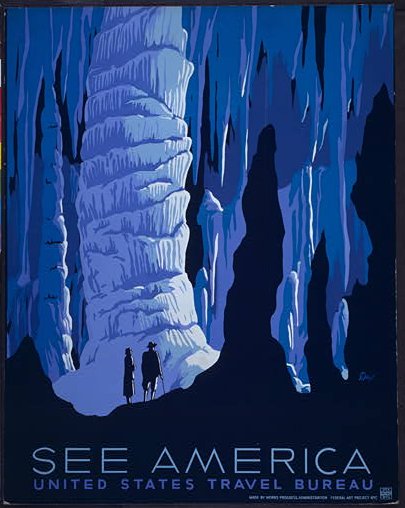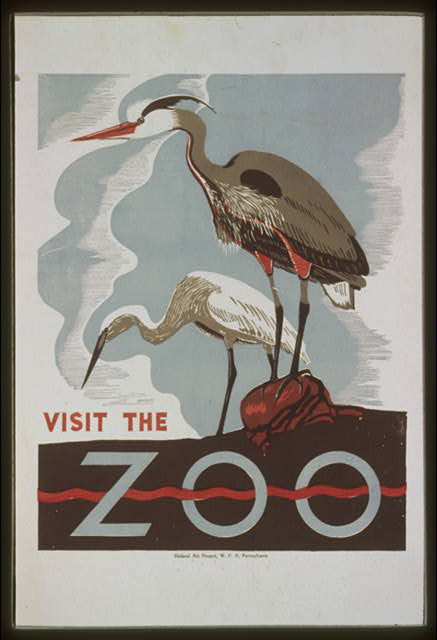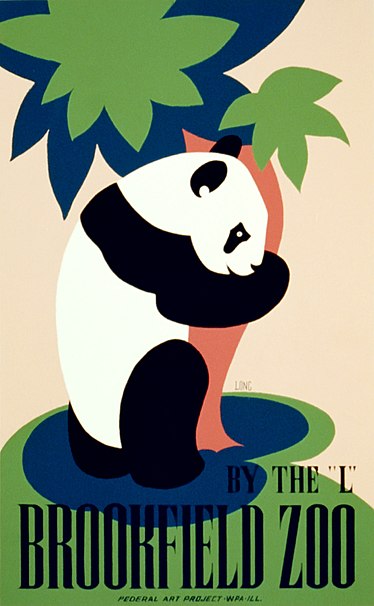.

Don't Kill Our Wild Life: John Wagner, 1940 (Dept of Interior/National Park Service)
I remember as a child in Europe gloating over a map of North America that had "Appalachian Mountains" boldly running from Alabama up to New Brunswick, so that the whole region they spanned -- Tennessee, the Virginias, Pennsylvania, New York, Vermont, New Hampshire and Maine, appeared to my imagination as a gigantic Switzerland or even Tibet, all mountain, glorious diamond peak upon peak, giant conifers, le montagnard émigré in his bear skin glory, and Felis tigris goldsmithi, and Red Indians under the catalpas. That it all boiled down to a measly suburban lawn and a smoking garage incinerator, was appalling. Farewell, Appalachia! Leaving it, we crossed Ohio, the three states beginning with "I," and Nebraska -- ah, the first whiff of the West! We travelled very leisurely, more than a week to reach Wace, Continental Divide, where she passionately desired to see the Ceremonial Dances marking the season opening of Magic Cave, and at least three weeks to reach Elphinstone, gem of a western state were she yearned to climb Red Rock from which a mature screen star had recently jumped to her death after a drunken row with her gigolo.
Again we were welcomed to wary motels by means of inscriptions that read:
"We wish you to feel at home while here. All equipment was carefully checked upon your arrival. Your license number is on record here. We reserve the right to eject without notice any objectionable person. Do not throw waste material of any kind in the toilet bowl. Thank you. Call again. The management. P.S. We consider our guests the Finest People of the World."
Vladimir Nabokov: from Lolita, 1955

See America: Alexander Dux, c. 1936-1939 (WPA
Federal Art Project)

The National Parks Preserve Wild Life: Bighorn Sheep: J. Hirt, 1939 (Dept. of Interior/National Park Service)

Spare Our Trees: Stanley Thomas Clough, 1938 (Federal Art Project, Ohio)

Grand Canyon: artist unknown, c. 1938 (Dept. of Interior/National Park Service)

Lassen Volcanic National Park: artist unknown, 1938 US (Dept. of Interior/National Park Service)

See America: Frank S. Nicholson, c. 1936-1938 (WPA
Federal Art Project)

Chicago Brookfield Zoo: artist unknown, 1938 (WPA Federal Art Project, IIlinois)

Wild Life: The National Parks Preserve All Life: Frank S. Nicholson, 1940 (New York City Art Project/Work Projects Administration)
All posters from Works Projects Administration Poster Collection, Library of Congress

the advice at the end of the quoted paragraph is intelligent enough to warn with so much gentleness...:)
ReplyDeleteTom,
ReplyDelete"Please, Mr. President, don't kill our wildlife."
11.7
grey whiteness of fog against invisible
ridge, golden-crowned sparrow’s oh dear
in foreground, sound of wave in channel
see “drawing after painting,”
boy with a small face
in which each being happens
itself, there, itself
cloudless blue sky reflected in channel,
sunlit green of pine in tip of sandspit
They were just mountains,
ReplyDeletethere, in the blue distance.
Later, I heard they were The Smokies
and we went there because they were close
and gasoline was rationed and the ocean was far away.
I took a pillowcase, intending to capture a cloud
on Mt. Leconte and bring it home to sleep on.
Silly boy. Awake in dreams.
Yet they allowed me to believe I could.
Did we always think it would stay this way,
our wildness?
"I took a pillowcase, intending to capture a cloud"
ReplyDeleteSo beautiful, Mr. Nabokov would blush at this with pleasure! Nyet?
Thanks, Susan.
ReplyDeleteHumbert Humbert, almost hungry for his disillusionment, for the taste of disgust.
ReplyDeleteInventing and disappearing wilderness at the same time, all in Early Disney tints.
Here's how to make a National Park.
Please be informed that for as long as we manage to hold out here on the ledge of the tottering state known as Hellas, you are all welcome guests at our Milk and Honey (Meli-Gala) House.
ReplyDeleteP.S. The injunction to refrain from throwing any politicians in the toilet bowl is no longer in effect.
Oh yes, and then there are the gas stations that don't allow you to use their bathrooms at all . . .
ReplyDeleteYou aren't from these parts, are ye?
Oh yeah. That hostility towards the college kids or the Yankees or the city folks or . . .
We have this nutcase across the road who shoots deer in his backyard. Yeah, it's legal. Drunk, he's chasing a doe he's been feeding all summer long--with its fawn. Oh, I love this country. Really, I do.
The Finest People of the World would never do something objectionable. Well, actually, everybody I consider the finest are nothing but objectionable.
ReplyDeleteNabokov had a unique perspective on America, combining the objectivity and distance of a detached observer (a sophisticated and cosmopolitan European) with the familiarity of a traveler who had actually covered much of the continent on the ground and paid close attention to its distinguishing features (especially motels), for many years, before writing with such comic brilliance of those travels.
ReplyDeleteSee:
Map of Nabokov's tours to the West, 1941-1953
Map of the transcontinental trips in Lolita. Click on the red/yellow dot #46 to locate the passage quoted in this post.
As to the WPA poster project, it was part of a larger program intended to bring art to the people and the people to art, while also generating a useful bit of income for needy and skilled artists. The program employed hundreds of out-of-work practitioners of the visual arts, ranging from social realists to budding abstractionists (e.g. Jackson Pollock). Their products were not "conceptual" or "theoretical" but actual objects made by actual human hands.
See:
Employment and Activities poster for the WPA's Federal Art Project, 1 January 1936
Oh and by the way -- Nin's comment about the Ohio backyard Deer Hunter touched a nerve. And not only in the deer.
ReplyDeleteThe freeway feeder out front would make that mickey mouse deerslayer proud to be an American. Deer killing, next best yankee yahoo pleasure after carbon extraction.
One recalls Sarah Palin's congenial invitation, a few years back, to the faux Nicolas Sarkozy (actually a Montreal radio show prankster) to come over to Alaska for a bit of helicopter-borne elk shooting.
Right here on our busy traffic frenzied American corner, in our 28 resident years not only six humans (I was meant to be #7 -- the Fatal Accident Team was disappointed however to discover the bloody scraped-up remains still breathing), but countless deer, straying down out of the hills in search of a drink, have been run over. A death sentence for the crime of attempting to cross the street while not in an armoured vehicle.
Having got up the rare courage to set foot out of the house during morning rush hour yesterday, I was informed by a neighbour, half-shouting to make himself heard over the steady roar of the metal beast-herd, that the evening before he'd seen a big adult male deer get hit by a speeding motorist on that same friendly corner, flung through the dark air onto the roadside scrabble, and then lie inert there where it had fallen.
"I went in and called Animal Control," he said.
"I don't know what they did with it, but in the morning it was gone."
Sigh.
To my knowledge none of the drivers in any of the above incidents was ever cited.
The Super-Pac of the Anti-Nature Brigade may have been defeated on Tuesday, but the rifle racks are still loaded and the trigger fingers are still itchy.
A guy in the north woods of Vermont who calls himself a poet once bragged to us defiantly (knowing our distaste for animal murdering) that he'd bagged a crew of squirrels he'd caught meddling with his survivalist food cache.
Why not just scare 'em away, we asked.
"Because they'd just come back," quoth the Mighty Hunter.
That's Nature for you. Always just coming back, coming back.